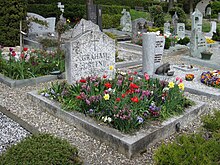Literary tourism

Literary tourism or Literary tourism is a form of educational or cultural tourism , in which the trial travelers or hikers in the footsteps of major writers follow. Sometimes literary tourism is also referred to as " literary tourism ". This suitcase word is a fusion of the words " literature " and " tourism ".
Destinations
In literary tourism, tourists (“literary tourists”) seek out places and sites that are related to the life and work of a writer or a group of writers . The locations are mostly
- Birth, residential, holiday or death houses and graves of writers,
- Schools and other educational institutions attended by writers,
- Travel and hiking routes of writers,
- real scenes of events in the writers' works,
- Bodies that can be shown or alleged to have encouraged writers to use fictional locations in their works, or
- Premises in which a literary group was founded, met or dissolved.
In the said buildings and their surroundings (. Eg often memorials literary museums , literary memorial room) set up to serve as a focal point of literary tourism (z. B. Goethe house , Schiller house ).
Memorial plaques on buildings where writers lived or worked play an important role as points of orientation in literary tourism.
Motives and Effects
Tourists visit such places in order to gain a better idea of the life of a writer or a deeper understanding of his work through personal observation. Occasionally, a visit to such a site during preparation or in the subsequent period triggers increased reading of works or a more intensive examination of the writer's life and work.
Special manifestations
In places or areas that have an accumulation of sites of significant literary history, tourism organizations often work out "literary walks", "poets' walks" or "literary hiking trails" ("literary tours") that are intended to lead interested parties to these sites (e.g. Goethe (wander) away , Schiller route ). The task of the suggested routes is to bring interested people closer to the literary heritage of the area and to encourage them to visit the area (possibly again) or stay longer.
The largest literary tourism routes in Germany are the German Fairy Tale Route , the Rheinische Sagenweg , the Schwäbische Dichterstrasse , the Siegfriedstrasse and the Nibelungenstrasse . The European Goethe Street is currently under construction .
Numerous literary travel guides are available in bookshops to help you find your way around areas of significant literary history . Some tourist offices also offer "literary city maps".
Economical meaning
Not least through the elaboration of literary walks, hiking trails and routes, literary tourism has developed into an independent economic factor and engine of tourism.
The most important sponsors, promoters and profiteers of literary tourism are:
- Authors and publishers of literary travel guides;
- Publishers who publish the works of the writers concerned ( partly also the writers themselves or their heirs via the royalties );
- Museums and memorials as well as their sponsoring associations ;
- Tour operators , travel agencies and transport companies / operators ;
- Companies in the hospitality industry ;
- the souvenir industry ;
- Companies in the advertising industry ;
- Communities .
Demarcation
For literary tourism , literary or poet memorials are rather insignificant .
Streets, squares and parks as well as public and scientific institutions that are named after a writer only to keep the public's memory alive do not count as literary tourism.
literature
- Hans Georg Bauner: Literary Leader France . Insel Verlag, Frankfurt am Main u. a. 2002, ISBN 3-458-34498-5 .
- Daniel Hahn, Nicholas Robins (eds.): The Oxford Guide to literary Britain and Ireland . Oxford University Press, Oxford u. a. 2009, ISBN 978-0-19-861460-9 .
- Doris Maurer , Arnold E. Maurer: Literary guide through Italy . Insel Verlag, Frankfurt am Main u. a. 1988, ISBN 3-458-32771-1 .
- Fred Oberhauser : Literary Leader Germany . Insel Verlag, Frankfurt am Main u. a. 2008, ISBN 978-3-458-17415-8 .
- Wolfgang Straub: Literary Leader Austria . Insel Verlag, Frankfurt am Main u. a. 2007, ISBN 978-3-458-17357-1 .
See also
Web links
Remarks
- ↑ Example: The Strudlhofstiege in Vienna, in the vicinity of which Heimito of Doderer's novel Die Strudlhofstiege or Melzer and the Depth of the Years (1951) plays.
- ↑ Example: The former Bachmann mill (today: "Wilhelm-Busch-Mühle") in Ebergötzen (Lower Saxony), which Wilhelm Busch took as a model for the mill in the seventh stroke of his picture story Max and Moritz (1864).
- ↑ Example: The house on the Bannwaldsee near Schwangau ( Ostallgäu district ), where the literary circle “Group 47” first met in 1947.
- ↑ In some cases, the boards only mark the places where the buildings, which have since been destroyed, stood.
- ↑ Such areas are sometimes referred to as "literary landscapes" or "literary topographies ".
Individual evidence
- ↑ Literary Tourism , on hisour.com, accessed December 3, 2019
- ↑ Qualitätsweg Goethewanderweg , on ilmenau.de, accessed on December 3, 2019
- ↑ Goethe-Wanderweg , on weimarer-land-tourismus.de, accessed on December 3, 2019

